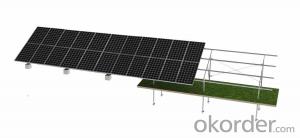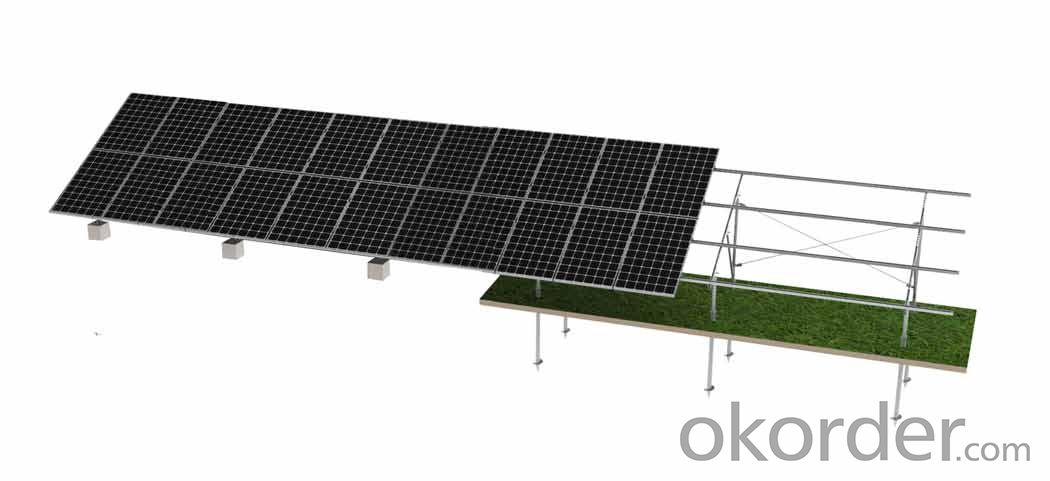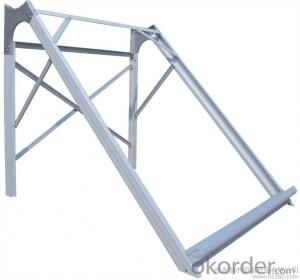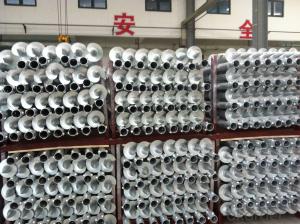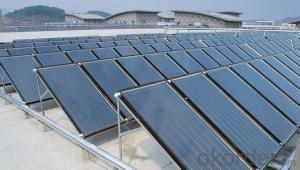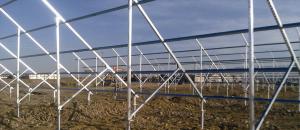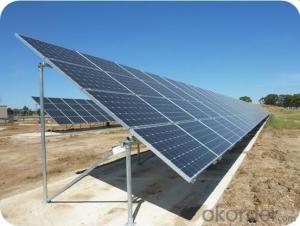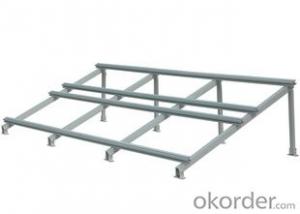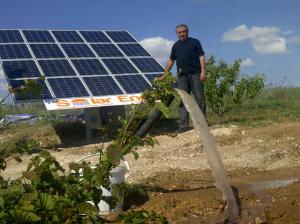Solar Heat Energy Double Screw Pile Ground System
- Loading Port:
- China Main Port
- Payment Terms:
- TT OR LC
- Min Order Qty:
- -
- Supply Capability:
- -
OKorder Service Pledge
OKorder Financial Service
You Might Also Like
Packaging & Delivery
Packaging Detail:Normal package seaworthy
Delivery Detail:15 days
Specifications
Easy installation Competitive price TUV&SGS test report & CSA certification 15-warranty
Specifications
1) Super smooth beautiful appearance,outstanding quality,large supply.
2) Available in customized surface finishes.
3) Well machined,for example,cutting,drilling and milling with excellent tolerance.
4) Meet with customer’s designs and supply you best price.
5)Usages:Supply for solar panel modules.
Technical characteristics
Installation site:
ground,hillside,and grassland
Installation angle
it is based on customers’ requirements
Installation height
it is basedon customers’ requirements
Solar panel type; with or without frame
Components arrangement :horizontal or vertical
Support track
aluminum alloy extrusion
Quality warranty
15 years
Advantages
1)Quick installation: with high degree of pre-installed rate, the system could be easily installed by using galvanized carbon steel rails for PV Stent, and specially designed connection parts of the PV bracket, which could reduce installation time and cost greatly.
2)Offer unmatched durability: with all structural components comprised of high class stainless steel and anodized aluminum alloy, it is designed for 25 years service life and backed by 15 years warranty.
3)Stand up to extreme weather: The SuninTek solar mount is designed to stand up to the extreme weather complied with the AS/NZ 1170 and other international structure load standard by the skilled engineer. The main support components also have been tested to guarantee its structure and load-carrying capacity.
4)Provide broad installation flexibility: These systems accommodate most commercially available framed solar panels , and they can scale easily from small to large, multi-megawatt installations.
5)Diversified Application: The PV mounting system produced can be adopted by various types of PV cells panels which you can find in the market. It can serve for both mini solar power system and huge plant with megawatt capability.
Main features
1. Installation cost savings.
2. Save installation time.
3. Increase the mechanical strength of solar energy mounting to ensure that wind requirements.
4. The outdoor for installation of solar energy.
5. Length can be customized according to customers.
6. Service life of up to 25 years.
7. Products through the international certification.
8. Stent material composition of the galvanized steel and aluminum.
9. 15 years system and structural guarantee.
10.Flexible post spacing withstands different wind & snow loads.
11. High quality material in Aluminium 6005-T5 and SUS 304.
12.Screws and nuts go with every components needed.
13.Mechanical calculation and reliability tested to ensure highest product quality.
- Q: Can solar energy systems be used for powering water pumping systems?
- Yes, solar energy systems can be used for powering water pumping systems. Solar-powered water pumping systems use photovoltaic (PV) cells to convert sunlight into electricity, which can then be used to power water pumps. This provides a sustainable and cost-effective solution for pumping water in remote areas or locations without access to electricity grids.
- Q: How do solar energy systems impact water usage?
- Solar energy systems have a positive impact on water usage as they significantly reduce the amount of water needed for electricity generation compared to traditional fossil fuel power plants. Solar power does not require any water for its operation, whereas conventional power plants consume large amounts of water for cooling purposes. This water consumption can be detrimental to local ecosystems and water resources, especially in areas with limited water availability. Moreover, solar energy systems indirectly contribute to water conservation by reducing the reliance on other water-intensive energy sources. By shifting towards solar power, we can reduce the need for coal or natural gas power plants that consume vast amounts of water for cooling and extraction processes. This reduction in water usage not only preserves local water resources but also helps mitigate water scarcity issues that many regions face. Additionally, solar energy systems can also be integrated with water management infrastructure to further optimize water usage. For instance, solar panels can be installed on reservoirs or other water bodies, providing shade and reducing evaporation rates. This helps to conserve water and maintain reservoir levels, which are crucial for agriculture, drinking water supply, and ecosystem health. In summary, solar energy systems have a positive impact on water usage. They eliminate the need for water consumption in electricity generation and reduce reliance on water-intensive energy sources. Moreover, solar power can be combined with water management infrastructure to optimize water usage and conserve water resources. By embracing solar energy, we can contribute to a more sustainable and water-efficient future.
- Q: How do solar energy systems impact the electricity grid?
- Solar energy systems impact the electricity grid by reducing the demand for electricity from traditional power plants and lowering overall electricity costs. They also contribute to a more resilient and decentralized grid by generating electricity closer to where it is consumed, reducing transmission losses and enhancing grid stability. However, the intermittent nature of solar power can pose challenges for grid operators in terms of managing fluctuations in supply and demand.
- Q: Can solar energy systems be financed or leased?
- Yes, solar energy systems can be financed or leased. Many companies offer financing options for homeowners and businesses to install solar panels and other solar energy systems. These financing options allow the cost of the system to be spread out over a period of time, making it more affordable for customers. Additionally, leasing options are available where the solar panels are owned and maintained by a third-party company, and the customer pays a monthly lease fee for the use of the system. These financing and leasing options have made solar energy more accessible to a larger number of people and have contributed to the rapid growth of the solar industry in recent years.
- Q: What is the role of solar batteries in storing excess solar energy?
- The role of solar batteries in storing excess solar energy is to capture and store the energy produced by solar panels during times of peak sunlight, allowing it to be utilized later when sunlight is not available, such as during the night or on cloudy days. This enables a more reliable and consistent supply of renewable energy, reducing dependence on the grid and increasing self-sufficiency.
- Q: Can solar energy systems be used in areas with limited access to solar energy financing options?
- Yes, solar energy systems can still be used in areas with limited access to solar energy financing options. There are alternative financing options available such as leasing or power purchase agreements (PPAs) where homeowners or businesses can still benefit from solar energy without the need for upfront costs. Additionally, government incentives, grants, and community-driven initiatives can also help make solar energy more affordable and accessible in such areas.
- Q: How does the tilt angle of solar panels affect energy production?
- Determining the efficiency of energy production relies heavily on the tilt angle of solar panels. The tilt angle refers to how inclined the panels are in relation to the horizontal plane. This angle can be adjusted to optimize energy generation based on location and time of year. The tilt angle primarily affects the amount of solar radiation received by the panels. By tilting them at the optimal angle, maximum sunlight can be captured throughout the day. Generally, the best tilt angle for solar panels is equal to the latitude of the location to maximize yearly energy output. During summer, when the sun is high in the sky, a smaller tilt angle is preferred to capture more direct sunlight. Conversely, during winter, when the sun is lower, a steeper tilt angle is necessary to capture sunlight at a lower angle. Adjusting the tilt angle throughout the year ensures that the panels receive sunlight at the most favorable angle, maximizing energy production. If solar panels are not tilted optimally, they may receive sunlight at a less efficient angle, resulting in lower energy generation. Incorrectly steep or shallow tilts could prevent the panels from capturing the maximum amount of solar radiation, reducing their energy production potential. Additionally, the tilt angle affects the self-cleaning capability of solar panels. By tilting them, rainwater can wash away accumulated dust, debris, and particles on the surface. This self-cleaning mechanism helps maintain high energy production levels by keeping the panels clean and obstruction-free. In conclusion, the tilt angle of solar panels significantly impacts energy production. Optimally adjusting the tilt angle allows for better capture of solar radiation, maximizing energy generation. Considering geographical location and seasonal variations enables solar panel owners to position their panels optimally for increased energy production efficiency.
- Q: What is the role of disconnect switches in a solar energy system?
- The safe isolation of a solar energy system from the grid or other power sources is made possible by disconnect switches, which play a crucial role. During maintenance, repairs, or emergencies, these switches act as a safeguard by allowing the complete disconnection of solar panels or inverters from the electrical grid. A key function of disconnect switches is to protect both the system and the individuals involved in its operation. By preventing the flow of electricity from the solar panels to the grid, they ensure that no power is being generated or transferred during maintenance or repairs. This helps minimize the risk of electric shocks or accidents. In addition, disconnect switches help meet safety regulations and codes. They enable easy and quick disconnection of the solar energy system, which is often required during inspections or in the event of emergencies such as fires or natural disasters. By isolating the system, these switches help prevent any potential damage to the system or the grid. Furthermore, disconnect switches allow for efficient monitoring and control of the solar energy system. They provide a convenient way to shut down the system when necessary, facilitating troubleshooting or routine checks. By disconnecting the solar panels, inverters, or battery storage systems, these switches optimize the overall system's efficiency and performance. In conclusion, disconnect switches in a solar energy system ensure the safety of individuals involved, comply with safety regulations, protect the system and the grid from damage, and enable efficient monitoring and control. As an essential component, these switches enable the safe and effective operation of solar energy systems.
- Q: What is the role of solar energy in achieving energy independence?
- Solar energy plays a crucial role in achieving energy independence by providing a clean, renewable, and abundant source of power. It reduces our dependence on fossil fuels, mitigates climate change, and promotes sustainability. Solar power empowers individuals, communities, and even entire nations to generate their own electricity, reducing reliance on imported energy and creating a more resilient and self-sufficient energy system.
- Q: Can solar energy systems be used for indoor lighting?
- Yes, solar energy systems can be used for indoor lighting. Solar panels can be installed on rooftops or in outdoor areas to capture sunlight, which is then converted into electricity and stored in batteries. This stored energy can be used to power lights indoors, providing a sustainable and cost-effective lighting solution.
Send your message to us
Solar Heat Energy Double Screw Pile Ground System
- Loading Port:
- China Main Port
- Payment Terms:
- TT OR LC
- Min Order Qty:
- -
- Supply Capability:
- -
OKorder Service Pledge
OKorder Financial Service
Similar products
Hot products
Hot Searches
Related keywords
